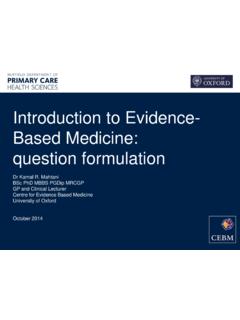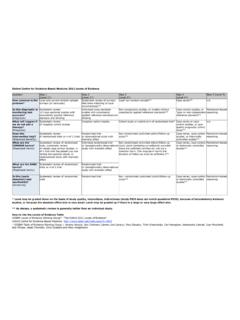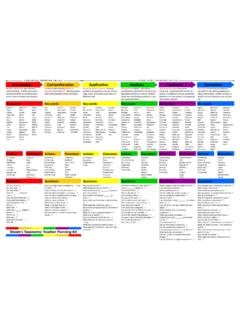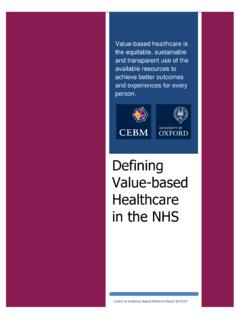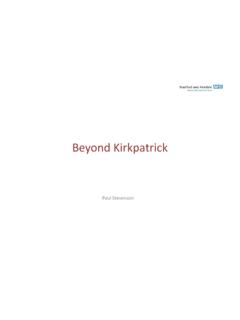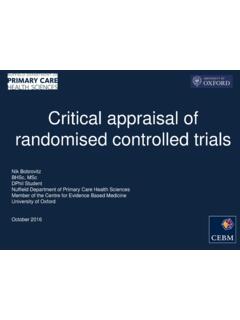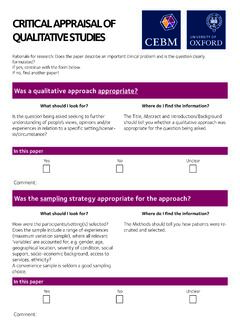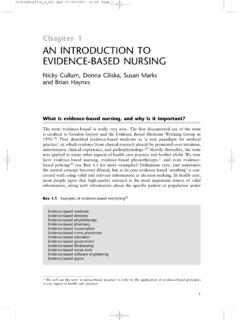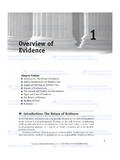Transcription of Introduction to Evidence-Based Medicine
1 To Evidence-Based MedicineProf. Carl Heneghan Director CEBM University of Oxford is Evidence-Based Medicine ? Evidence-Based Medicine is the integration of best research evidence with clinical expertise and patient values Why do we need EBM? do we need RANDOMIZED CONTROLLED TRIALS ? In the early 1980s newly introduced antiarrhythmicswere found to be highly successful at suppressing arrhythmias. Not until a RCT was performed was it realized that, although these drugs suppressed arrhythmias, they actually increased mortality. The CAST trial revealed Excess mortality of 56/1000.
2 By the time the results of this trial were published, at least 100,000 such patients had been taking these drugs. For every 1000 patients treated 65 more will be alive at 1 month if treatment is administered in the first hour the golden hour after symptom onset, compared with not giving thrombolysis; 37 lives are saved for every 1000 patients treated in the 1 2 hour interval after symptom onset; 26 lives are saved for every 1000 patients treated in the 2 3 hour interval after symptom onset; 29 lives are saved for every 1000 patients treated in the 3 6 hour interval after symptom onset.
3 20 lives are saved for every 1000 patients treated in the 7 12 hour interval after symptom onset. Allocation to antiplatelet therapy produced a highly significant reduction (P< ) of 38 per 1000 in the risk of suffering a subsequent vascular eventPain relief Beware of text books A 21st century clinician who cannot critically read a study is as unprepared as one who cannot take a blood pressure or examine the cardiovascular system. BMJ 2008:337:704-705 EBMasamedicalstudent?Be aware that treatment options should be based on clinical need and the effectiveness of treatment options, and that decisions should be arrived at through assessment and discussion with the patientMust be aware of their responsibility to maintain their knowledge and skills throughout there are expected to keep up to date and to apply knowledge necessary for good clinical care.
4 What skills will you need to keep up to date with the best evidence ? to find the evidence more efficiently to appraise the quality of the evidence more effectively to use good quality evidence more systematicallyMust be aware of their responsibility to maintain their knowledge and skills throughout there are expected to keep up to date and to apply knowledge necessary for good clinical care. about 1/2 of valid evidence today is out of date in 5 1/2 of valid evidence is not implementedthe steps of practicing EBM1. Ask a focused Track down the evidence 3.
5 Critically appraise evidence for its validity, effect size, precision4. Apply the evidence in valid evidence with other relevant information (values & preferences, clinical/health issues, & system issues) the decision in practice1. Aska focused presenting with MI Background QuestionsAbout the disorder, test, treatment, Root* + Verb: What causes .. b. Condition: HIV? * Who, What, Where, When, Why,Patient presenting with MI are the symptoms and signs of someone presenting with MI? 2. What are the diagnostic tests for MI?3. What are the causes of MI?
6 4. What are the treatments of MI? Know your backgroundPatient presenting with MI Foreground QuestionsAbout actual patient care decisions and actionsFor treatment 4 (or 3) components:In Patients with a MI Does (I) cholesterol lowering therapy Compared to placebo reduce mortality (O) During the scheduled treatment period, there were 3832 (8 5%) deaths among the 45 054 participants allocated a statin compared with 4354 (9 7%) among the 45 002 controls. This difference represents a 12% proportional reduction in all-cause mortality per mmol/L LDL cholesterol reduction (RR 0 88, 95% CI 0 84 0 91; p<0 0001; figure 1).
7 Secondary PreventionLong-term Intervention with Pravastatin in Ischemic Disease (LIPID) StudyCHD Death (%) < RRRCHD=Coronary heart disease, MI=Myocardial infarction, RRR=Relative risk reductionLIPID Study Group. NEJM1998;339:1349 13579,014 patients with a history of MI or hospitalization for unstable angina randomized to pravastatin (40 mg) or placebo for yearsStatins provide significant benefit across a broad range of cholesterol levelsPatient presenting with MI 1. How commonis the problem Prevalence2. Is earlydetection worthwhile Screening3. Is the diagnostictest accurate Diagnosis4.
8 What will happenif we do nothing Prognosis 5. Does this intervention help Treatment 6. What are the commonharms of an intervention Treatment 7. What are the rare harms of an interventionTreatment Size of Medical Knowledge NLM MetaThesaurus 875,255 concepts million concept names Diagnosis Pro 11,000 diseases 30,000 abnormalities (symptoms, signs, lab, X-ray,) 3,200 drugs (cfFDAs 18,283 products)1 disease per day for 30 yearsTo cover the vast field of Medicine in four years is an impossible Olser05000001000000150000020000002500000 BiomedicalMEDLINET rialsDiagnostic?
9 Medical Articles per Year5,000?per day2,000 per day75 per dayArticles Per Yearwhy do we need to use evidence efficiently?EBP: informing decisions with the best up-to-date evidenceMedian minutes/week spent reading about my patientsSelf-reports at 17 Grand Rounds: Medical Students: 90 minutes House Officers (PGY1):0 (up to 70%=none) SHOs (PGY2-4):20 (up to 15%=none) Registrars:45 (up to 40%=none) Sr. Registrars 30 (up to 15%=none) Consultants: Grad. Post 1975:45 (up to 30%=none) Grad. Pre 1975:30 (up to 40%=none)Bastian, Glasziou, Chalmers PLoS 2010 Vol 7 | Issue 9 | e1000326more efficientlyclinical evidence increasing so rapidly we need better skills to keep up-to-date moreefficiently than previous generations of cliniciansthe steps of practicing EBM1.
10 Ask a focused Track down the evidence 3. Critically appraise evidence for its validity, effect size, precision4. apply the evidence in practice:a. amalgamatethe valid evidence with other relevant information (values & preferences, clinical/health issues, & system issues) and make an Evidence-Based decision; andb. implement the decision in practicethe steps of practicing EBM1. Ask a focused Track down the evidence 3. Critically appraise evidence for its validity, effect size, precision(NEXT month)4. Apply the evidence in valid evidence with other relevant information (values & preferences, clinical/health issues, & system issues) the decision in practiceIn the next 4 weeks Try to ask for one patient you have seen: causes the disease?
